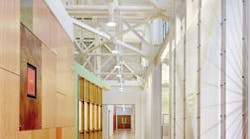This summer, Washington, D.C.-based green-building coalition, U.S. Green Building Council (USGBC), took its first official steps toward Version 3 (V3) of its Leadership in Energy and Environmental Design (LEED) program. In June, the organization held a charrette involving the organization's “power users,” otherwise known as people who use the program as a part of their jobs, such as consultants, owners, and government representatives.
Building on the approximately 40 proposals that came from that two-day meeting in mid-summer, the 70 LEED chapters were asked to involve their own constituents with the proposed changes. In September, concluding workshops on the issue included the “visionaries” — academics, authors, international proponents — in the green-building field to discuss the role of LEED in the future. Finally, that same month LEED held meetings with members of the federal government regarding the changes. From this point the LEED steering committee will further prioritize those issues, and then create a work plan and a schedule, which will be announced at Greenbuild, held Nov. 15-17.
Items on the short list of issues to address are tailoring the standards to location and climate, or a “bioregionally” weighted credit standpoint, as well as lifecycle assessment and further process refinements. “V3 will address more products, credits, enhancements, improvements, and changes in technologies and standard practice,” says Tom Hicks, vice president of LEED, USGBC. “We recognize this is the point that we need to start looking at our future and about what green buildings can be delivering in the future.”
Already certified buildings will not have to seek re-certification under Version 3. However, there will be opportunities for buildings in the process of certification to qualify for the new version. Currently, there are some buildings seeking certification for Version 2.2, as well as some registered for 2.0. “Any building that's earned its certification is time stamped with the year,” says Hicks. That will remain valid going forward. There wouldn't be an expectation or a motivation for buildings to re-certify under new construction in a different version.”




